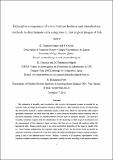Por favor, use este identificador para citar o enlazar a este item:
http://hdl.handle.net/10261/72713COMPARTIR / EXPORTAR:
 SHARE SHARE
 CORE
BASE CORE
BASE
|
|
| Visualizar otros formatos: MARC | Dublin Core | RDF | ORE | MODS | METS | DIDL | DATACITE | |

| Título: | Exhaustive comparison of colour texture features and classification methods to discriminate cells categories in histological images of fish ovary |
Autor: | González-Rufino, E.; Carrión, Pilar; Cernadas, Eva; Fernández-Delgado, M.; Domínguez-Petit, Rosario CSIC ORCID | Palabras clave: | Histological image Fish ovary Fecundity Stereology Classification Colour texture analysis Pyramid decomposition Multiresolution analysis Fractal analysis Local Binary Patterns Wavelets Co-ocurrence matrix Sum and Difference Histogram Support Vector Machine Statistical classifiers Ensembles Neural networks |
Fecha de publicación: | 2013 | Editor: | Elsevier | Citación: | Pattern Recognition 46(9): 2391-2407 (2013) | Resumen: | The estimation of fecundity and reproductive cells (oocytes) development dynamic is essential for an accurate study of biology and population dynamics of fish species. This estimation can be developed using the stereometric method to analyse histological images of fish ovary. However, this method still requires specialised technicians and much time and effort to make routinary fecundity studies commonly used in fish stock assessment, because the available software does not allow an automatic analysis. The automatic fecundity estimation requires both the classification of cells depending on their stage of development and the measurement of their diameters, based on those cells that are cut through the nucleous within the histological slide. Human experts seem to use colour and texture properties of the image to classify cells, i.e., colour texture analysis from the computer vision point of view. In the current work, we provide an exhaustive statistical evaluation of a very wide variety of parallel and integrative texture analysis strategies, giving a total of 126 different feature vectors. Besides, a selection of 17 classifiers, representative of the currently available classification techniques, was used to classify the cells according to the presence/absence of nucleous and their stage of development. The Support Vector Machine (SVM) achieves the best results for nucleous (99.0% of accuracy using colour Local Binary Patterns (LPB) feature vector, integrative strategy) and for stages of development (99.6% using First Order Statistics and grey level LPB, parallel strategy) with the species Merluccius merluccius, and similar accuracies for Trisopterus luscus. These results provide a high reliability for an automatic fecundity estimation from histological images of fish ovary. | Descripción: | 17 páginas, 9 tablas, 4 figuras | Versión del editor: | http://dx.doi.org/10.1016/j.patcog.2013.02.009 | URI: | http://hdl.handle.net/10261/72713 | DOI: | 10.1016/j.patcog.2013.02.009 | ISSN: | 0031-3203 |
| Aparece en las colecciones: | (IIM) Artículos |
Ficheros en este ítem:
| Fichero | Descripción | Tamaño | Formato | |
|---|---|---|---|---|
| Exhaustive_comparison_color_2013.pdf | 1,23 MB | Adobe PDF |  Visualizar/Abrir |
CORE Recommender
SCOPUSTM
Citations
56
checked on 25-mar-2024
WEB OF SCIENCETM
Citations
51
checked on 26-feb-2024
Page view(s)
343
checked on 22-abr-2024
Download(s)
461
checked on 22-abr-2024
Google ScholarTM
Check
Altmetric
Altmetric
NOTA: Los ítems de Digital.CSIC están protegidos por copyright, con todos los derechos reservados, a menos que se indique lo contrario.
